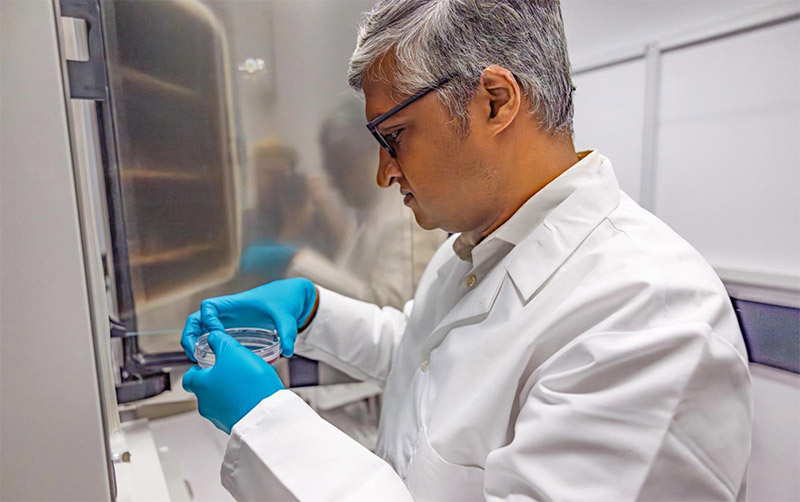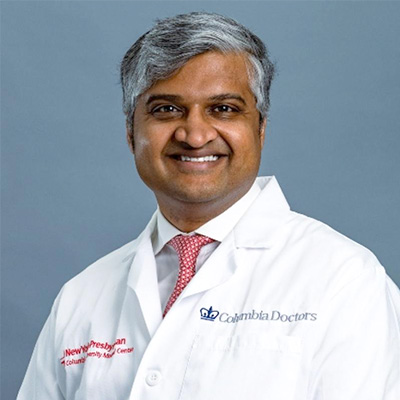Phosphoinositide 3-kinase (PI3K) is one of the most mutated proteins in breast and other cancers. Neil Vasan, MD, PhD, an oncologist at NewYork-Presbyterian/
Among those with estrogen receptor (ER) positive breast cancer, 40% of patients have a PI3K mutation in their tumor. Thanks to years of research, there is an approved PI3K inhibitor available for those with ER+ breast cancer – alpelisib. However, Dr. Vasan reports that the medication comes with significant side effects, making it important to understand who may respond to specific treatments based on their PI3K mutation. “Targets like PI3K will never cease to be important, given its critical role as a driver of almost all cancer types,” he says. “As a field, we need to know who the patients are who respond well and who the patients are who may not respond well based on their mutations. If we think they may not respond well, we could try a different therapy.”
Targets like PI3K will never cease to be important, given its critical role as a driver of almost all cancer types. As a field, we need to know who the patients are who respond well and who the patients are who may not respond well based on their mutations. If we think they may not respond well, we could try a different therapy.
— Dr. Neil Vasan
Advancing Discoveries to Provide Better Targeted Therapeutic Options
While a lot of research has been conducted already on PI3K, there is more to be done that will have implications for future cancer therapies. Dr. Vasan is right at the heart of this work – just a few years ago, he discovered that cancers with double PI3K mutations have important consequences for patients.
Double mutations hadn’t really been examined in any gene before Dr. Vasan’s study—the technology wasn’t quite ready to answer the question—but the phenomenon turns out to be common in other cancer genes. In breast cancer, where these double mutations are particularly prevalent, Dr. Vasan found that women whose cancers harbored double mutations responded better to PI3K inhibitors, a finding that’s now being investigated further in multiple clinical trials with select patients who may have increased benefit from PI3K inhibitors.
In his lab at the Herbert Irving Comprehensive Cancer Center at NewYork-Presbyterian/Columbia, Dr. Vasan and his team are asking novel questions and bringing new techniques to bear on old ones. With PIK3CA, for example, which encodes the catalytic subunit of PI3K alpha, researchers have worked extensively on only a few mutations – E542K, E545K, and H1047R. “There are three very common mutations, but they only explain about 50% of tumors in patients,” says Vasan. “So that means that 50% of patients with PIK3CA mutations have these rare mutations and we don’t know what they do or how they change PI3K inhibitor response,” he says.

Dr. Vasan's work to characterize PI3K mutations in women with breast cancer should guide the development of better PI3K inhibitors that have less toxicity, a problem that currently limits the dose that that can be used in patients. Photo courtesy of NewYork-Presbyterian/
To understand this further, Dr. Vasan recently worked on a study to comprehensively characterize tissue-specific and molecular subclasses of multiple PIK3CA mutations and assess their impact on potential therapies. He and his colleagues profiled a pan-cancer cohort of 352,392 samples across 66 tumor types using a targeted hybrid capture-based next-generation sequencing panel covering at least 324 cancer-related genes. “We wanted to better understand this phenomenon of multiple mutations in PIK3CA because this is a new phenomenon that has gone under appreciated by the field,” he says.
The results of the study, which were published in Clinical Cancer Research, showed that:
- Multi PIK3CA mutations are found in 11% of all PIK3CA-mutant tumors, including 9% of low tumor mutational burden (TMB) PIK3CA-mutant tumors and are enriched in breast and gynecologic cancers
- Among PIK3CA-mutant tumors with high TMB, 18% are multi PIK3CA mutant and often harbor apolipoprotein B mRNA-editing enzyme, catalytic polypeptide (APOBEC) mutational signature
- Patients with different classes of multi PIK3CA mutant ER positive, human epidermal growth factor receptor 2 (HER2) negative breast cancers respond similarly to PI3K inhibition
“We found that many of the genes that are mutated in cancer are actually not found in these patients with multiple mutations,” Dr. Vasan says. “To us, that suggested that these multiple mutations are able to drive the cancer process and they don’t need additional mutations from other canonical genes that can cause cancer. I think the big takeaway from this study is that the double mutations in PIK3CA comprises a bona fide oncogene.
I think the big takeaway from this study is that the double mutations in PIK3CA comprises a bona fide oncogene.
— Dr. Neil Vasan
“We’re seeing a lot of patterns in the pan-cancer mutational data that go together with the idea that this is a change in DNA that’s able to potentiate cancer by itself. We’re excited to model multiple PIK3CA mutations in these other cancer types to hopefully extend the therapeutic reach of PI3K inhibitors. We’re really excited about learning more about these cancer types to model these different multiple mutations in different cancer to hopefully extend the reach of PI3K inhibitors in cancer,” he says.
High-Risk, High-Reward Work to Find New Therapeutics
This year, Dr. Vasan was one of 58 investigators in the country to receive a prestigious New Innovator Award from the National Institutes of Health’s High-Risk, High-Reward program, which supports unusually innovative research from early-career investigators. Dr. Vasan’s project will extend his work on the PI3K kinase to all 556 kinase genes in the human genome. Kinases are one of the most important targets in precision oncology, but the ideal kinase targets or kinase drug combinations for most cancers have not been established.
In his project, Dr. Vasan will determine the consequences to cancer cells of turning off kinase enzymes, which has immense potential to transform our understanding of kinases and kinase inhibitors. “Kinases are large molecular machines with important functions in cancer, and kinase inhibitors are rather straightforward to design. We are particularly interested in trying to find new kinases that when you just turn them off, might kill cancer cells, much like turning off the ignition to your car,” he says.
Older methods of gene editing are not sufficient to answer the question, so Dr. Vasan will use newer base editing tools to turn off the activity in every human kinase across the kinome. This approach will identify novel kinases for therapeutic targeting but also identify the optimal mechanisms to inhibit kinases that will compress the discovery process of lead compounds from decades to years. “We have found a new way to turn off kinases using a new genome editing tool called base editing,” he says. “We’re really excited in using this to model what are the effects of turning off kinases. And we’re not just doing this in 1, 2, or 3 kinases – we’re doing this in every kinase in the human genome.”
We have found a new way to turn off kinases using a new genome editing tool called base editing. We’re really excited in using this to model what are the effects of turning off kinases. And we’re not just doing this in 1, 2, or 3 kinases – we’re doing this in every kinase in the human genome.
— Dr. Neil Vasan
The project will initially focus on breast cancer, where multiple kinase inhibitors are standard therapies but where new treatments are urgently needed. “But what’s even more exciting is that the framework we establish can be applied to any enzyme class in any physiologic process in mammals,” Dr. Vasan says. “It really has the potential to transform drug development across all fields of medicine.”
From Bench to Bedside: Keeping Patients Front of Mind
Dr. Vasan’s lab research delves into the complexities of the cancer cell, but the goal of his research is always to provide better options for his patients. “In the clinic, my patients with breast cancer want therapies that will extend their lifespan while maintaining excellent quality of life,” he says. “So the prospect of multiplying the number of therapeutic options for my patients using basic science motivates our work in the lab.”
I’m fortunate to be at a place like Columbia. I have amazing clinical collaborators who help me obtain tissue or analyze patient samples to connect the dots between patients and our powerful laboratory, which is helping us to transform treatments in real time.
— Dr. Neil Vasan
Dr. Vasan says that his role at NewYork-Presbyterian/Columbia enables him to advance this work. “I’m fortunate to be at a place like Columbia,” he says. “I have amazing clinical collaborators who help me obtain tissue or analyze patient samples to connect the dots between patients and our powerful laboratory, which is helping us to transform treatments in real time.”




